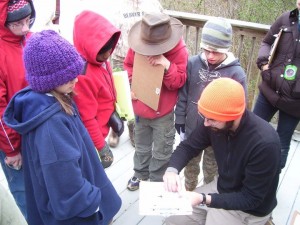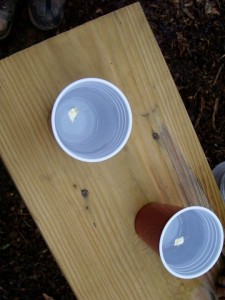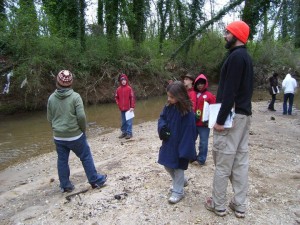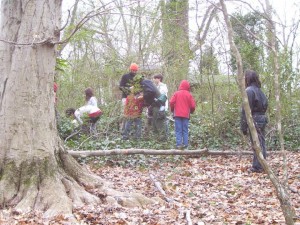 I recently taught a Mapping & Orienteering class for 10 kids and their parents from Homeschool Excursions. I highly recommend checking out this group. Vered, the director, puts together excellent and diverse programming for home school families. I love that Homeschool Excursions groups are racially, politically, geographically, and gender diverse.
I recently taught a Mapping & Orienteering class for 10 kids and their parents from Homeschool Excursions. I highly recommend checking out this group. Vered, the director, puts together excellent and diverse programming for home school families. I love that Homeschool Excursions groups are racially, politically, geographically, and gender diverse.
The class was held at the Clyde Shepherd Nature Preserve in Decatur, and it was cold that day! With the gorgeous weather we’ve had for the past week, it blows my mind to think that we almost called off this class because it was snowing when we woke up!
The first father and son to arrive were into scouting and the young man was attempting to get an orienteering merit badge. I’ve was only a Webelos Scout for two years in elementary school, so I had no idea what BSA would require for a merit badge. It actually made me a little nervous: “Am I teaching enough skills and in enough depth?” Luckily, when I flipped through the merit badge book, I found that my class covers most topics, though I’m not as focused on terminology as BSA is. As with most things I do, this class is focused on practical orienteering skills.
 Nevertheless, the class must start with a discussion of the concepts of longitude and latitude. Then, we looked at top maps of our area and tried to find clues on the map that would help us figure out, without a compass or GPS, where we are. We looked at contour lines, landmarks, bodies of water, roads, etc. Finally, we pulled out the GPS and pinpointed our location using longitude & latitude coordinates.
Nevertheless, the class must start with a discussion of the concepts of longitude and latitude. Then, we looked at top maps of our area and tried to find clues on the map that would help us figure out, without a compass or GPS, where we are. We looked at contour lines, landmarks, bodies of water, roads, etc. Finally, we pulled out the GPS and pinpointed our location using longitude & latitude coordinates.
Compass-making was next, and we each built a magnetic compass using a needle (that we magnetized by rubbing on a magnet), a styrofoam float, water, and a plastic cup. Why do we do this? Making a compass teaches us how and why a compass works. This knowledge makes the use of a store-bought compass more intuitive.
 So, we took our store-bought compasses, blank maps of the nature preserve, and our wits and walked the entire length of the park, identifying landmarks, deciding which direction to go, and looking at the flora & fauna. The kids were particularly intrigued by the landmark I call “The Beach” and navigated us towards where they thought it might be. We found it – a sandy area along South Peachtree Creek – and the kids spent awhile playing, climbing trees, and running around (playing in nature is one of my favorite parts of any class).
So, we took our store-bought compasses, blank maps of the nature preserve, and our wits and walked the entire length of the park, identifying landmarks, deciding which direction to go, and looking at the flora & fauna. The kids were particularly intrigued by the landmark I call “The Beach” and navigated us towards where they thought it might be. We found it – a sandy area along South Peachtree Creek – and the kids spent awhile playing, climbing trees, and running around (playing in nature is one of my favorite parts of any class).
Once the kids led us back to our outdoors classroom using their maps and compasses, I told them that everything they had done today was wrong! Yes, wrong, because we did not correct for magnetic declination. (Come take the class, if you’d like to learn more.) I like leaving that lesson to the end because I think it drives it home more forcefully the fact that one small degree of difference can cause all calculations to be disastrously incorrect.
 Finally, I introduced the participants to geocaching, the international treasurer-hunting game. We created and hid a cache (the kids named it “The Beach” after their favorite part of the Nature Preserve), and then I posted it online for others to find. As of when this post was written, 11 people have already found and logged our cache!
Finally, I introduced the participants to geocaching, the international treasurer-hunting game. We created and hid a cache (the kids named it “The Beach” after their favorite part of the Nature Preserve), and then I posted it online for others to find. As of when this post was written, 11 people have already found and logged our cache!
Despite the chilly weather, I thoroughly enjoyed teaching this class with these participants and look forward to bringing another group to the Clyde Shepherd Preserve soon!
Homeschool Excursions has also posted an excellent photo diary of the class on Facebook.
